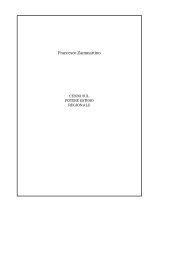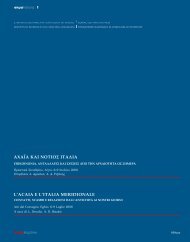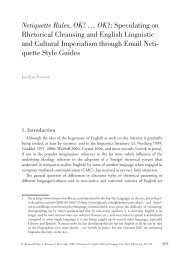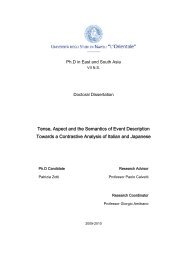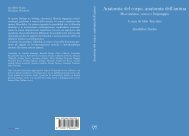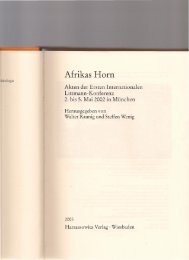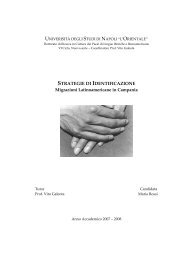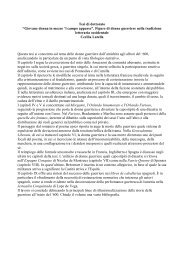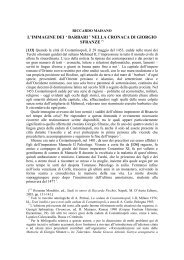- Page 3 and 4: Società di Linguistica Italiana Gr
- Page 5 and 6: Questa opera è protetta dalla Legg
- Page 7 and 8: 149 The pragmatic ground of flores
- Page 9 and 10: Parte VII - Strumenti e tecniche pe
- Page 14 and 15: esame, in § 3 verrà descritta la
- Page 16 and 17: giovani anziani NOME ETÀ PROFESSIO
- Page 18 and 19: ello, -mente, -etto). Come si mostr
- Page 20 and 21: 5 Dittonghi e monottonghi nello spa
- Page 22 and 23: L‘estensione del fenomeno di ditt
- Page 24 and 25: Di un certo interesse anche i dati
- Page 26 and 27: Figura 4: Coefficienti di dittongaz
- Page 28 and 29: parlata 23 . Inoltre, nelle produzi
- Page 30 and 31: Riferimenti bibliografici Abete, G.
- Page 32 and 33: Analisi prosodica della cronaca in
- Page 34 and 35: 1.2. Strutturazione sintattica del
- Page 36 and 37: Il nostro primo sub-corpus comprend
- Page 38 and 39: locutore che costruisce il commento
- Page 40 and 41: delle fasi attive succedono a fasi
- Page 42 and 43: duplice movimento melodico con un
- Page 44 and 45: Nella figura 4, troviamo un esempio
- Page 46 and 47: Figura 6: Gomarsall au pied c‘est
- Page 48 and 49: vero per quanto attiene alla prosod
- Page 50 and 51: locutore-giornalista nel suo discor
- Page 52: Léon, P. R. (1993), Précis de pho
- Page 55 and 56: su costituenti che possono essere u
- Page 57 and 58: 3 Metodologia di analisi qualitativ
- Page 59 and 60: 1990; 1997; Blanche-Benveniste et a
- Page 61 and 62:
inizialmente prominente e che si ri
- Page 63 and 64:
Caso 2 IP3 IP1 IP5 quindi rivolt
- Page 65 and 66:
IP3 io passo sopra gli sci o no ?
- Page 67 and 68:
IP3 eh no no arriva arriva fino a
- Page 69 and 70:
C1 IP1 aiuto esiste mo
- Page 71 and 72:
ima intonativa: il loro skeleton di
- Page 73 and 74:
C3 IP3 lato gizey
- Page 75 and 76:
Caso 10 C1 IP1 m
- Page 77 and 78:
- (1990) ‗Un modèle d‘analyse
- Page 80 and 81:
Il parlato dei mass media: analisi
- Page 82 and 83:
2 Stato dell‟arte I risultati di
- Page 84 and 85:
3 Scopo del lavoro e corpus I cambi
- Page 86 and 87:
telegiornali in cui erano presenti
- Page 88 and 89:
sillabe/s sono quelli relativi all
- Page 90 and 91:
In figura 6 si può notare come, in
- Page 92:
enero de 2005, actas-II, Santiago d
- Page 95 and 96:
aventi caratteristiche fonetiche 's
- Page 97 and 98:
andamenti melodici specifici in ass
- Page 99 and 100:
e object move possono essere differ
- Page 101 and 102:
polari, selezionano diversi eventi
- Page 103 and 104:
codifica parallela fornisce probabi
- Page 105 and 106:
La conseguenza immediata è che le
- Page 107 and 108:
discendente e ascendente, lo scalin
- Page 109 and 110:
discussione precedente, però, si p
- Page 111 and 112:
significato o funzione ed evento to
- Page 113 and 114:
piuttosto che quello di ‗introduc
- Page 115 and 116:
Carletta, J. et al. (1996) HCRC Dia
- Page 117 and 118:
108
- Page 119 and 120:
isultarne un suono d‘insieme sent
- Page 121 and 122:
correnti correnti culturali cultura
- Page 123 and 124:
nel 1753). Anche compositori della
- Page 125 and 126:
del repertorio delle vocali, della
- Page 127 and 128:
degni di essere considerati a parte
- Page 129 and 130:
4.3.2 Segno di “non flessibilità
- Page 131 and 132:
De Dominicis, A. (1999 2 ) Fonologi
- Page 133 and 134:
Philipp, M. (1974) Phonologie des D
- Page 135 and 136:
126
- Page 137 and 138:
studio dei foni /r/ nelle varietà
- Page 139 and 140:
alcune pronunce regionali 5 tra cui
- Page 141 and 142:
parlanti di una varietà di STI-i,
- Page 143 and 144:
ʀ ʀ ʀ ʁ χ V˞ cancellazione
- Page 145 and 146:
Figura 2: fricativa uvulare sorda,
- Page 147 and 148:
nel corpus. Si sono pertanto distin
- Page 149 and 150:
come a una mappa strutturale della
- Page 151 and 152:
per lo più un‘occlusiva sorda (p
- Page 153 and 154:
La dimensione 1 invece distingue i
- Page 155 and 156:
altoatesini e ha consentito di trat
- Page 157 and 158:
Vietti, A., L. Spreafico and A. Rom
- Page 159 and 160:
loose, appositive, and mainly parat
- Page 161 and 162:
Quite differently, the judgment on
- Page 163 and 164:
L‘ordre n‘est pas indifférent;
- Page 165 and 166:
discusses matters of style in the V
- Page 167 and 168:
inflamed with anger (incensum ira),
- Page 169 and 170:
focusing function which in English
- Page 171 and 172:
Di Benedetto (1994) illustrates how
- Page 173 and 174:
Kiparsky, P. (1976) Oral Poetry: So
- Page 175 and 176:
166
- Page 177 and 178:
168
- Page 179 and 180:
1.1 Il focus Il focus è da intende
- Page 181 and 182:
Lo studio dei connettivi nella ling
- Page 183 and 184:
di scritto letterario che comprende
- Page 185 and 186:
1.5 I focalizzatori Carla Bazzanell
- Page 187 and 188:
Nell‘esempio 2, il focus è evide
- Page 189 and 190:
introduca un discorso indiretto ret
- Page 191 and 192:
Esempio 15: *LID: sì / INP perché
- Page 193 and 194:
Esempio 16: *SRB: però / INP il ti
- Page 195 and 196:
1.12 Incidenza delle funzioni svolt
- Page 197 and 198:
Savy (eds) Atti del Convegno “Il
- Page 199 and 200:
Searle, J. (1969) Speech Acts: An E
- Page 201 and 202:
La nuova varietà emergeva dall‘o
- Page 203 and 204:
diverse tratti dal corpus CLIPS dia
- Page 205 and 206:
Per questo studio sono stati utiliz
- Page 207 and 208:
Nel suo complesso, il corpus LIP co
- Page 209 and 210:
esplicativa (cfr. es. (8)) o, appun
- Page 211 and 212:
Città Numerosità Percentuale Bari
- Page 213 and 214:
Per prima cosa sono stati confronta
- Page 215 and 216:
Secondo questa ipotesi, quindi, la
- Page 217 and 218:
A. Cardinaletti (eds) Grande gramma
- Page 219 and 220:
Gesprochenes Italienisch in Geschic
- Page 221 and 222:
In seconda battuta, va notato che l
- Page 223 and 224:
appare esaltato. A parte l‘uso di
- Page 225 and 226:
costruzione a completiva. In terza
- Page 227 and 228:
Figura 2 Figura 3 218
- Page 229 and 230:
verbali, nominali e aggettivali, me
- Page 231 and 232:
2.4 Ansia e angoscia L‘appartenen
- Page 233 and 234:
Se queste sono le occorrenze dei le
- Page 235 and 236:
Gross, M. (1997) The Construction o
- Page 237 and 238:
Marco Civoli 1 , con la collaborazi
- Page 239 and 240:
argomentale di una modificazione di
- Page 241 and 242:
(30) dentro Camoranesi # vicino a L
- Page 243 and 244:
che parla e sulla questione si torn
- Page 245 and 246:
(71) Klose # quindi Totti di prima
- Page 247 and 248:
(76) A: e poi qui Zambrotta il dest
- Page 249 and 250:
una telecronaca sportiva, in N. Pep
- Page 251 and 252:
ha l‘obiettivo di classificare al
- Page 253 and 254:
Esaminando nel dettaglio le diverse
- Page 255 and 256:
5.1 Frase aggettivale con struttura
- Page 257 and 258:
singoli lemmi, non lo è per quanto
- Page 259 and 260:
RB9 H: non si non si non non si pre
- Page 261 and 262:
Ciascun dei quattro nodi (Paura N,
- Page 263 and 264:
avrebbe tradito completamente la na
- Page 265 and 266:
20) Il fatto che Mario parta preocc
- Page 267 and 268:
258
- Page 269 and 270:
1 Introduzione Lo studio dell‘im
- Page 271 and 272:
trascritto che permette di visualiz
- Page 273 and 274:
figura di enumerazione, figura dell
- Page 275 and 276:
(6) 7 *ELA: [129] questa / tu sei a
- Page 277 and 278:
paradigmatico caratteristico di que
- Page 279 and 280:
Il prototipo formale è la figura d
- Page 281 and 282:
(11) 21 ELA: dove l‘è vicino a+
- Page 283 and 284:
[...] LEO: [
- Page 285 and 286:
MAX: accidenti // e questo è il ba
- Page 287 and 288:
formali e funzionali delle figure q
- Page 289 and 290:
Nicolás Martínez, C. (2008) Prime
- Page 291 and 292:
syntactic and prosodic levels. This
- Page 293 and 294:
visto anche se il palco è un po‟
- Page 295 and 296:
Fig. 1 shows a prefix, interrupted
- Page 297 and 298:
Fig. 5 shows a prefix followed by a
- Page 299 and 300:
the kernel ends with a comples fina
- Page 301 and 302:
292
- Page 303 and 304:
294
- Page 305 and 306:
sulle loro implicazioni. La formula
- Page 307 and 308:
l‘analisi che sarà proposta nell
- Page 309 and 310:
ambini, suggerendo un‘inferenza s
- Page 311 and 312:
comprensione dell‘agente, sia ria
- Page 313 and 314:
dal marcatore so. La formulazione
- Page 315 and 316:
(..) especially in Sweden and I tho
- Page 317 and 318:
S12 17 OpF1: so you could never ans
- Page 319 and 320:
analizzare sia l‘orientamento ai
- Page 321 and 322:
su aspettative affettive aprono al
- Page 323 and 324:
314
- Page 325 and 326:
nelle scienze sociali e contribuir
- Page 327 and 328:
sarebbe dovuto servire al governo f
- Page 329 and 330:
cultura viene contemporaneamente se
- Page 331 and 332:
It occurred to me that you may be i
- Page 333 and 334:
When one considers the changes whic
- Page 335 and 336:
Figura 1: Quattro dei sei Inuit por
- Page 337 and 338:
diversi anni lo stato federale stat
- Page 339 and 340:
Il problema allora per una linguist
- Page 341 and 342:
e discorso: un lessico per le scien
- Page 343 and 344:
334
- Page 345 and 346:
Per questi aspetti, il testo teatra
- Page 347 and 348:
In sostanza, per quanto sia classif
- Page 349 and 350:
appare svincolato dalle tradizional
- Page 351 and 352:
del resto questo aspetto si riflett
- Page 353 and 354:
Diversamente, per Marco Paolini - c
- Page 355 and 356:
Si registra una più alta frequenza
- Page 357 and 358:
Il procedimento dominante del monol
- Page 359 and 360:
Fenomeni strettamente connessi con
- Page 361 and 362:
5.3 Davide Enia: il ritmo arcaico d
- Page 363 and 364:
Inoltre intere battute risultano co
- Page 365 and 366:
marcati da opzioni dialettali (Cele
- Page 367 and 368:
narrati e la visione d‟en bas o p
- Page 369 and 370:
Atti del Congresso Internazionale (
- Page 371 and 372:
0 Introduzione Nel mio intervento v
- Page 373 and 374:
2 Lavori precedenti Il mio interess
- Page 375 and 376:
dialogica in ottava rima, non tanto
- Page 377 and 378:
énonciations a été grandement é
- Page 379 and 380:
6.1 I Saluti Propongo come esempio
- Page 381 and 382:
turno del poeta che realizza la sua
- Page 383 and 384:
C‟è gente da ufficio e da salott
- Page 385 and 386:
interstrofici, i primi tre versi pa
- Page 387 and 388:
parola. Tali restrizioni intervengo
- Page 389 and 390:
di scontri reiterati nel tempo tra
- Page 391 and 392:
Massaini, M. (2005) Transumanza. Da
- Page 393 and 394:
384
- Page 395 and 396:
linguistica per le diverse unità d
- Page 397 and 398:
formalmente la frase: la struttura
- Page 399 and 400:
eccezionali è infatti difficilment
- Page 401 and 402:
normale, apparentemente corretta ma
- Page 403 and 404:
Pazienti descrizione immagine Produ
- Page 405 and 406:
Figura 1: Le tre strutture - produz
- Page 407 and 408:
marcato, mentre il clitico viene pr
- Page 409 and 410:
Bettoni, C. and G. Ginelli (in pres
- Page 411 and 412:
development: Processability Theory.
- Page 413 and 414:
quanto sfuggenti alle tradizionali
- Page 415 and 416:
Follower. In questo senso, la gesti
- Page 417 and 418:
F Come vengono usati i pronomi, i d
- Page 419 and 420:
in cui si incontra cioè la person
- Page 421 and 422:
(10) 5 F#6: […] io veramente feci
- Page 423 and 424:
F#344: ah sì se lui l‘entità ch
- Page 425 and 426:
F#416: # è sempre la stessa# perso
- Page 427 and 428:
G#125: me lo puoi spiegare ? perch
- Page 429 and 430:
non si ha motivo di dubitare della
- Page 431 and 432:
Cresti, E. (1987) L‘articolazione
- Page 433 and 434:
424
- Page 435 and 436:
La Sindrome di Down manifesta una s
- Page 437 and 438:
consenso dei familiari e dei respon
- Page 439 and 440:
sostituzione e cancellazione non ha
- Page 441 and 442:
4 La variazione allofonica I fonemi
- Page 443 and 444:
fumo fumo, lo stopping (13%), ad es
- Page 445 and 446:
pronuncia polivibrante, i segmenti
- Page 447 and 448:
già complesso. Talora, il tratto d
- Page 449 and 450:
Il comportamento sillabico di /s/,
- Page 451 and 452:
selezione delle marche morfologiche
- Page 453 and 454:
troppo esiguo per avanzare generali
- Page 455 and 456:
lingua seconda; a tale riguardo Gia
- Page 457 and 458:
principali indici di fluenza, deter
- Page 459 and 460:
in speech pathology and therapy, Am
- Page 461 and 462:
Knudsen, E.I. (2004) ‗Sensitive p
- Page 463 and 464:
neuropathological findings in two n
- Page 465 and 466:
456
- Page 467 and 468:
comunicazione istituzionale che ved
- Page 469 and 470:
al cliente, o paziente, la capacit
- Page 471 and 472:
sono di tipo parallelo e complement
- Page 473 and 474:
Mantenere costante lo scambio tra s
- Page 475 and 476:
sociali e di volontariato (Biggio:
- Page 477 and 478:
icerca per il quale in molti casi i
- Page 479 and 480:
P.M. Dott. ASTORI - Sì, ma il fumo
- Page 481 and 482:
puntini sospensivi che chiudono sia
- Page 483 and 484:
giudiziario percorsi formativi che
- Page 485 and 486:
476
- Page 487 and 488:
is the case with all rule-based sys
- Page 489 and 490:
they are ordered in the grammar: wh
- Page 491 and 492:
clause-level interpretation procedu
- Page 493 and 494:
words which are only partially prod
- Page 495 and 496:
IBIS structures from meeting events
- Page 497 and 498:
Automatic Argumentative Annotation
- Page 499 and 500:
establishes that, for instance, Que
- Page 501 and 502:
needs to be made available to the f
- Page 503 and 504:
analysis of this pronoun. They also
- Page 505 and 506:
verbs exhibit for arguments of diff
- Page 507 and 508:
then take care of the antecedent an
- Page 509 and 510:
overlaps and uses that information
- Page 511 and 512:
EVALUATIVE CONTENT:negative, ARGUME
- Page 513 and 514:
dial_act('Morgan'-nil, spact, 35, f
- Page 515 and 516:
Müller, Ch. (2006) Automatic Detec
- Page 517 and 518:
finally, spoken texts are full of d
- Page 519 and 520:
1.2 No punctuation marks Usually, c
- Page 521 and 522:
ileGF0 mm ilePA2 now a hopper er gr
- Page 523 and 524:
la langue fourche quoi ilrMS1 je sa
- Page 525 and 526:
3.2 Sentence segmentation Tradition
- Page 527 and 528:
Blanche-Benveniste, C., B. Borel, J
- Page 529 and 530:
appliquée 4, 2, pp. 113-33. Véron
- Page 531 and 532:
successiva, rappresenta una traccia
- Page 533 and 534:
2.2 Sequenzialità Per l‘AC ogni
- Page 535 and 536:
che si riproducono senza apparenti
- Page 537 and 538:
essere riprodotte fedelmente in for
- Page 539 and 540:
complessità di interazioni che avv
- Page 541 and 542:
sequenze di azioni. Offrendo la pos
- Page 543 and 544:
emarginazione di f1. L‘interazion
- Page 545 and 546:
Che cosa offre la VO a una ricerca
- Page 547 and 548:
ogni volta in cui si affronta nuova
- Page 549 and 550:
(Italian) multi-person interaction
- Page 551 and 552:
capacità di riconoscere il parlato
- Page 553 and 554:
terminologia del settore, dunque, p
- Page 555 and 556:
Come si vede, le sosituzioni posson
- Page 557 and 558:
paese c) Pronunciato: visto che ***
- Page 559 and 560:
conoscenza linguistica del sistema:
- Page 561 and 562:
acustica, sia l‘analisi contestua
- Page 563 and 564:
Figura 1: Il client sviluppato da C
- Page 565 and 566:
SOSTITUZIONI CANCELLAZIONI INSERZIO
- Page 567 and 568:
di linguaggio tarato il più possib
- Page 569 and 570:
questo 690951 come 678866 gli 66213
- Page 571 and 572:
per la prima 26346 è la 26035 di
- Page 573 and 574:
564
- Page 575 and 576:
completamento della fase precedente
- Page 577 and 578:
and Thompson, 1996; 2002) - e, più
- Page 579 and 580:
descrive tre tentativi di realizzar
- Page 581 and 582:
fratello. Inizia da questo momento
- Page 583 and 584:
azione sia nella disposizione dinam
- Page 585 and 586:
(1) Per la descrizione del gesto, l
- Page 587 and 588:
3.1.3 Mantenere il turno I partecip
- Page 589 and 590:
(1.6) 20080122divorzioGesto2bigliet
- Page 591 and 592:
Epifani, in questo caso, utilizza i
- Page 593 and 594:
MAIUSCOLO volume le parole più for
- Page 595 and 596:
http://www.anthro.ucsd.edu/~jhavila
- Page 597 and 598:
588
- Page 599 and 600:
1 Introduzione I cambiamenti demogr
- Page 601 and 602:
2 Il “focus group” come strumen
- Page 603 and 604:
contrario, sostiene l‘autrice, l
- Page 605 and 606:
della malattia e delle prassi di cu
- Page 607 and 608:
discorsi tanto rispetto al tema del
- Page 609 and 610:
Rispetto al modo in cui essi erano
- Page 611 and 612:
and evidence-based practice‘. Psy
- Page 613 and 614:
uses, but we are especially more co
- Page 615 and 616:
observable in other contexts; at a
- Page 617 and 618:
Legibility and lexicon of the polit
- Page 619 and 620:
- semantic weight carried out on th
- Page 621 and 622:
typically spoken structures and com
- Page 623 and 624:
ut to picture numerous new lines of
- Page 625 and 626:
Basile, G. and F. Diodato (in press
- Page 631:
I due volumi raccolgono i contribut



